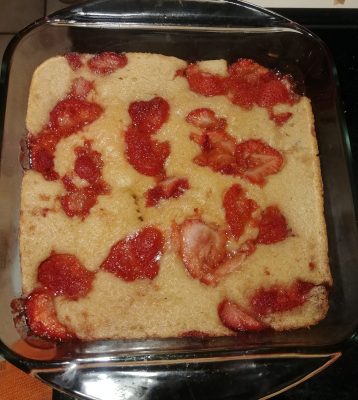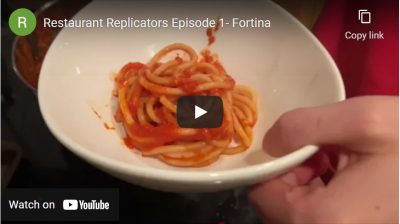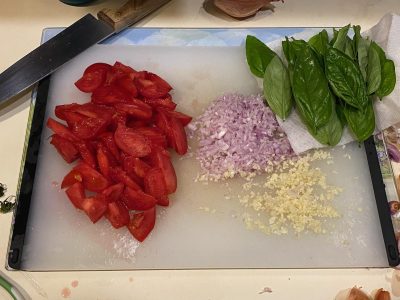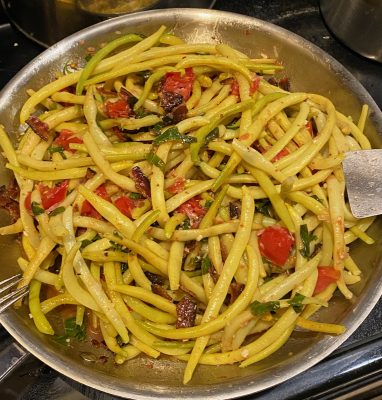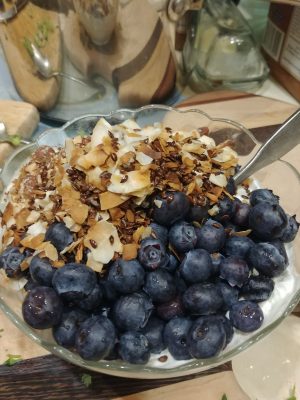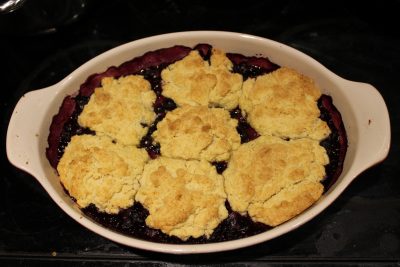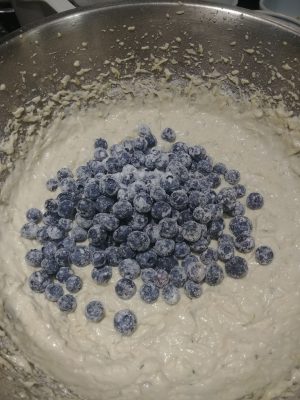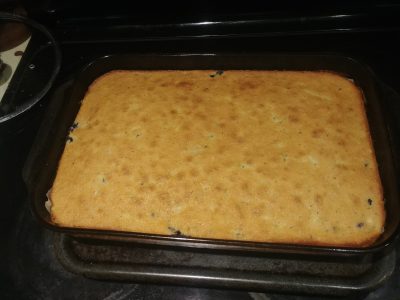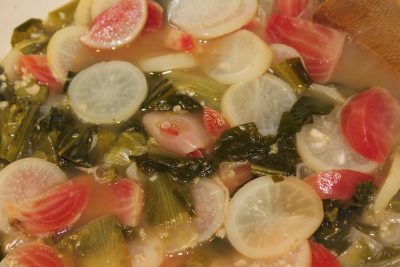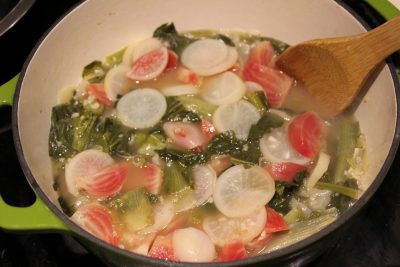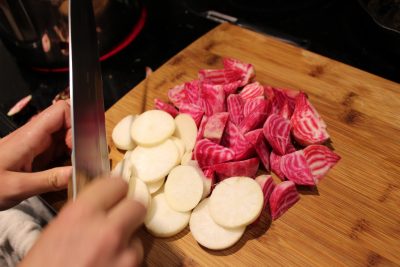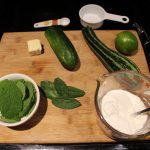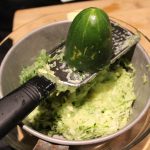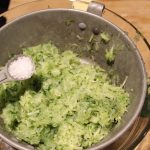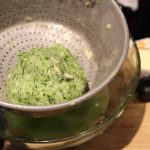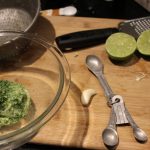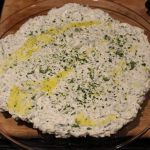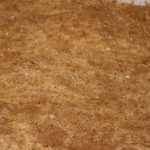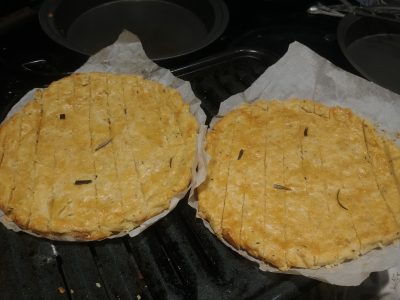
watercolor by Marja van Mierlo
We are pleased to feature content created by our participants each week, including recipes, essays, poems, cooking demonstrations, and pictures. If you would like your content featured on this page, become a participant!
Rachel’s Charred Summer Street Corn
Rachel Laemle is a rising sophomore at UConn, majoring in communications with a heavy interest in nutrition. She recently founded ‘College Chefette,’ her personal food blog containing recipes, honest restaurant reviews, fails in the kitchen, and more exciting posts. On this same platform, she began ‘Restaurant Replicators,’ a group for foodies and home chefs to make their closest replication to specific restaurant dishes. With this group, she hopes to inspire chefs to try something new and plate their food in a professional, crafty way. She also aims for this community to be a place where chefs can meet each other and form friendships over food. As well as being a place to share personal copycat challenges, ‘Restaurant Replicators’ offers competitions for chefs to design the most similar replication. Participate in the first competition here: Thai Lettuce Wraps.

Recipe:
- 10 ears of corn (husked)
- 1/2 cup cilantro (taken off stem and chopped)
- 1 clove garlic (minced)
- 1/2 cup mayo
- 1/2 cup sour cream
- 1/4 teaspoon red pepper flakes
- 2 teaspoons lime zest
- 2 tablespoons lime juice
- 1/2 cup cotija cheese
- Place your ears of corn on a hot grill. Cook, rotating periodically, until they are charred/have grill marks all around. This will take about 25 minutes (until desired charness.)
- In the meantime, whisk the mayo, sour cream, cilantro, garlic, red pepper flakes, lime zest, and lime juice in a medium bowl.
- When corn is done, remove from the grill and place on a serving plate. Rub the sauce on top (you can spin the ears of corn to cover more surface area with the sauce.)
- Sprinkle the corn with cotija cheese.
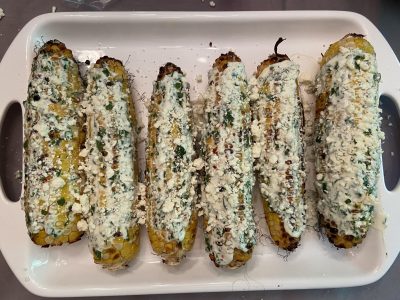
Yes to Yellow Beans
According to the National Gardening Association, one quarter of U.S households in 2019 planted vegetable gardens, which surprises the heck out of me and gives me hope. What I’ve seen as niche turns out to be ordinary and widespread. There’s a lot of room for difference in that sea of American growers, and with that in mind, I feel there’s room for me to express that I planted green beans with a single-track mind towards turning them into Martha Rose Shulman’s gussied up version of casserole. It feels weird to write, because Alice Waters’ farm-to-table ideal haunts my gardening, suggesting that the highest enjoyment of your produce is found in having it fresh and ‘true to its nature.’ I felt slightly pathetic: is there something wrong with me that I basically just want to blanch these and cover them up with bacon, gruyere, alium etc.? With something like 40 Beurre de Rocquencourt and Calima plants, I have a veritable forest of legume-tangle, teeming with potential. After a watering session devolved into an all-hands-on-deck effort to harvest, and our bag was filled with over 4 pounds of beans–equal parts Beurre and Calima–my mind was swirling with ideas. Looking at all this yield in the flesh, there was no way I could now go on and make casserole for days. There must be something.
Luckily, my sister, always a proponent of Food and Wine recipes, found one for the yellow half of our harvest: “Warm Yellow Wax Beans in Bacon Vinaigrette.” We were blown away by the aroma, texture, and freshness of the dish. Initially wary of all the acidic ingredients on our counter, we discovered that it was very much needed to balance the bacon fat and olive oil and didn’t interfere with the delicacy of the bean flavor. Although it was nearly all vegetable (tomatoes were from Barberry Hill Farm!), the bacon added a heartiness to the dish that made it a satisfying alternative to pasta in 85-degree weather. From prepping to serving, it took only half an hour. In that half-hour, my single-mindedness, my casserole obsessive disorder, was cured. This is what I’ve loved about gardening myself: through the generosity of their growth, I am forced to confront my vegetables for all that they are.
-Will Platt
A Twist on Madhur Jaffrey’s Chicken with Roasted Coriander in a Coconut Curry Sauce
There’s ginger in the fridge. It’s been there for two weeks and the thought of it getting moldy depresses me. Tonight I’ll return to one of my all-time favorite books, Madhur Jaffrey’s Indian Cooking, to see what I can create from the random assortment of spices and veggies I have on hand: coriander (whole and ground), black peppercorns, yellow mustard seeds, cinnamon sticks, ground fenugreek, ground cayenne pepper, turmeric, ripe farm-stand tomatoes, onions, French beans, new potatoes (purple and pink), lemons, 1.3 Ibs chicken thighs, and coconut oil.
Although I’m short two pounds of chicken, I’ve decided to substitute it with the potatoes and green beans which I will blanch in a pot of boiling vegetable and beef broth and add just before stewing my chicken with coconut milk. Instead of adding water to cover, I will pour in the excess blanching broth on top, and use any that remains to cook my rice in.
I’ve just discovered that I only have Jasmine sticky rice in the pantry…what to do?! I’m going to add a tablespoon of salted butter, six dried curry leaves, and two teaspoons of dehydrated coconut flakes to liven it up. Nothing like the basmati I’m supposed to be serving this curry with, but hey, maybe it will exceed my expectations.
Officially a new favorite recipe. The rice had so much depth to it and it absorbed the tomato-coconut juices from the curry beautifully. I could live without its stickiness, but otherwise, the flavor is exquisite. Jaffrey says her recipe “has a goodly amount of delicious sauce, so eat it with rice and a vegetable of your choice. This is an ideal dish for entertaining.” Well, I guess I just combined this suggestion into one, and I’m quite pleased with the turnout. Next time I have a dinner party—and with the rapid return to normalcy, that should be very soon—I’m going to make this recipe, potatoes, beans, and all, perhaps including those 5 cloves I just discovered I missed tonight (lol) and a big pot of coconutty, curry basmati with a touch of lemon zest.
Cheers to experimenting.

 -Sarah
-Sarah
Vanilla Bean Rhubarb Scones
5/2/2021
It was finals week when I tried this recipe. Young leaves were bursting out and coloring the treetops a bright green. Birds were singing their little hearts out. The spring smell was perfuming the air. I am a spring baby so maybe I’m a little biased, but I can never get over the spring season. It’s pure joy.
But finals week—perhaps many of you recall—tends to be the opposite of joy. I always make sure to treat myself to a little something special at the end. To make up for my rhubarb-less spring 2020, I decided to make rhubarb vanilla bean scones this time.
My father used to come home from the market with a big bushel of rhubarb when I was little and stew it in a pot with a touch of orange zest and cane sugar. That tangy-sweet taste has stuck with me ever since and I’m eager to bring it to life, scone-style.
Note to my green thumbs and chem nerds: rhubarb is a perennial that grows from thick, short rhizomes. Its leaves contain high levels of oxalic acid, a nephrotoxin, so please don’t eat them! Vanilla originated in Mesoamerica, which includes parts of modern-day Mexico, but today the majority of vanilla plantations are found on the islands of Madagascar and Réunion.

ingredients:
- 2 cups all-purpose flour (240 grams)
- ¼ cup granulated sugar (50 grams)
- 1 tablespoon baking powder
- ¼ teaspoon kosher salt
- 1 tablespoon orange zest (from about 1 navel orange)
- 5 tablespoons cold unsalted butter, cut into 1/2 inch cubes (70 grams)
- ¾ chilled cold heavy whipping cream (175 ml)
- 1 large egg
- 1 5-inch vanilla bean, halved lengthwise and seeds carefully separated from the stem
- 1 ½ cup fresh rhubarb (150 grams)
Glaze
- 1 cup powdered sugar, sifted (227 grams)
- ½ teaspoon vanilla extract
- 1-2 tablespoons heavy whipping cream
- you should have a fair amount leftover
Instructions
- Preheat the oven to 400°F. Line a sheet pan with parchment paper.
- Chill your butter in the freezer for 5 minutes.
- In a large bowl combine the flour, sugar, baking powder, salt, and orange zest. Cut your chilled butter and use your finger to lightly work the butter into the dry ingredients until it is roughly the size of small peas.
- In a separate bowl, whisk together the cream, egg, and scraped vanilla beans. Add to the dry ingredients and mix with a large spoon until the mixture just begins to come together. Add rhubarb slices and continue to mix until it comes together into a ball. The mixture may still be slightly crumbly, but don’t fret.
- Transfer the crumbly dough to a lightly floured surface and pat it into a disk about 1 inch thick. Cut into 8 triangles and evenly space each scone on the prepared sheet pan. Paint the tops with a little bit of heavy cream and sprinkle with a touch of demerara sugar, if desired. Bake the scones until the bottoms are golden, fr about 15 minutes. Let cool completely on a cooling rack.
- To make the glaze, whisk together the powdered sugar, vanilla, and enough cream to make a thick but pourable glaze. Drizzle over scones and let sit for about 5 minutes before serving.
- Scones are best within the hour they are baked, but they will keep in an airtight container at room temperature for up to 3 days. You can also freeze them before baking by wrapping them tightly in plastic wrap and enjoy them throughout the month.
This recipe was adapted from Bake to the Roots blog.
Slipping into Summer Mode
6/6/2021
Hi there! So glad you’ve landed here. Welcome (back) to the blog. It’s a glorious late spring weekend in Madison. The Sound is but a mere 56°F today but the air is warm and fragrant, carrying wafts of beach rose, seaweed, and iris as it sweeps through the treetops. After more than six months of chilly grey days, this kind of weather feels heavenly. Currently, I’m reclining under the shade of tall tulip poplar, soaking in as many of the sounds and smells of new life as I can. It’s a long-needed meditation.
Last year at this time, everything was unpredictable. It felt like we were all going through the motions without really knowing what was going to happen next. I’m relieved to say that this is no longer the case. Over half of Madison residents are fully vaccinated which means that we can start throwing away these awful masks (or face diapers, as one resident put it) that have made us afraid of ourselves and each other, which have caused us so much discomfort and frustration over the past two years, and which are a constant reminder of life’s brevity.
I don’t know about you but I’m dreaming of picnicking for every meal. Whether it be on the Madison Town Green, Bauer Park, Rettich Preserve, Rockland Preserve, or even down by the water, the ability to gather outside with friends and family I haven’t seen in a long time is what I’m most looking forward to this summer.
I’m starting things out simple. This week, rhubarb will be the star, and, of course, strawberries the side-kick. Rhubarb is one of those vegetables that take you right back to your childhood yet it’s wonderfully sophisticated and elegant in desserts. I hope you will share your own rhubarb explorations and give feedback on the recipes I share!
Christine M. recreated Chef Nour’s Syrian Garden Salad recipe
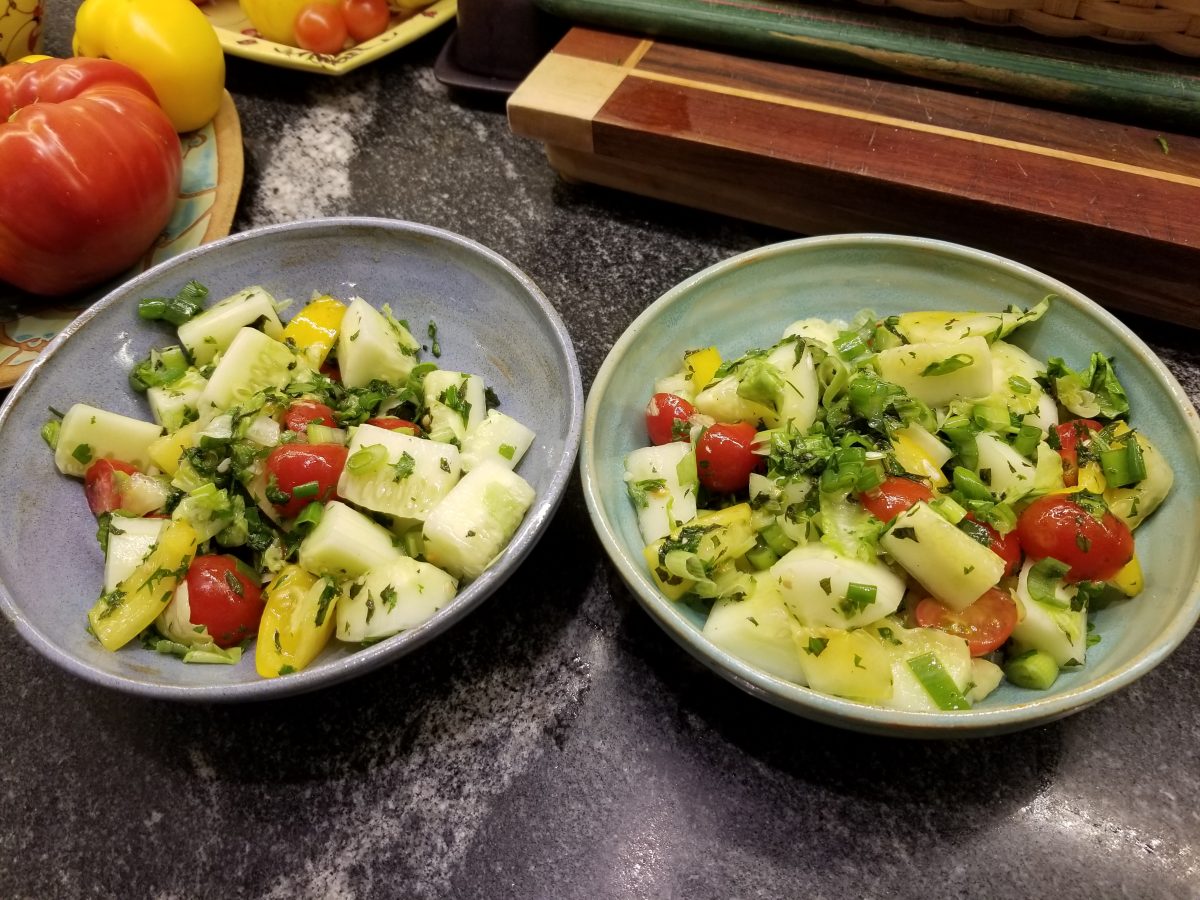 Homegrown tomatoes and cucumbers.
Homegrown tomatoes and cucumbers.
Ever wondered what’s in salsa verde?
Here’s our go-to recipe for salsa verde using the fresh tomatillos we have growing in the garden.
Ingredients:
- 1 1/2 lb tomatillos, halved (about one dozen medium-sized)
- 1/2 cup chopped white onion, chopped (medium-sized)
- 2 cloves (or more) garlic, whole
- 1/2 cup cilantro leaves, chopped
- 2 tbsp fresh lime juice (about 1-2 limes juiced, or to taste)
- 2 Jalapeño peppers, 2 serrano peppers, or one of each (depending on your heat tolerance), stemmed, seeded and chopped (you can use whole for more heat if you want)
- Salt to taste (about 1 teaspoon)
Instructions:
First, peel the papery leaves off the tomatillos and rinse them well. You can choose to either oven roast them or skillet sear them. Cut your tomatillos in half and place the cut side down on a foil-lined baking sheet. Add a few whole garlic cloves to infuse the fruits while baking. Place them under a broiler for about 6 minutes to lightly blacken the skins. If you prefer your stovetop, coat the bottom of a skillet with some sunflower oil and turn up the heat to medium/high. Place the tomatillos in the pan and sear them on one side with a few whole garlic cloves, then flip them over to brown on the other side and remove from the heat. Make sure you don’t overcook them so all the juices spill out and cook in the pan. The fruits should remain intact, just deflate, and change color. Once the roasted tomatillos have cooled down slightly, pulse them with the lime juice, onions, garlic cloves, cilantro, jalapeños (or serranos if heat isn’t your thing) in a blender or a food processor and pulse until all the ingredients are finely chopped and mixed well. Finally, add about a teaspoon of salt to bring out all of the flavors and cool it in the refrigerator for about 3 hours before serving.
Coconut mango lime creamy dream cake
Made with six ripe mangoes, two limes, coconut milk, and shredded coconut (plus honey and coconut flour for extra depth and nuttiness) this cake is truly stunning for any formal celebration and it tastes even better chilled the next day. The salt may startle you at first but don’t be discouraged. It brings out the best in the fruit. Check out Jerrelle Guy’s Black Girl Baking cookbook for the recipe. It’s splendid.
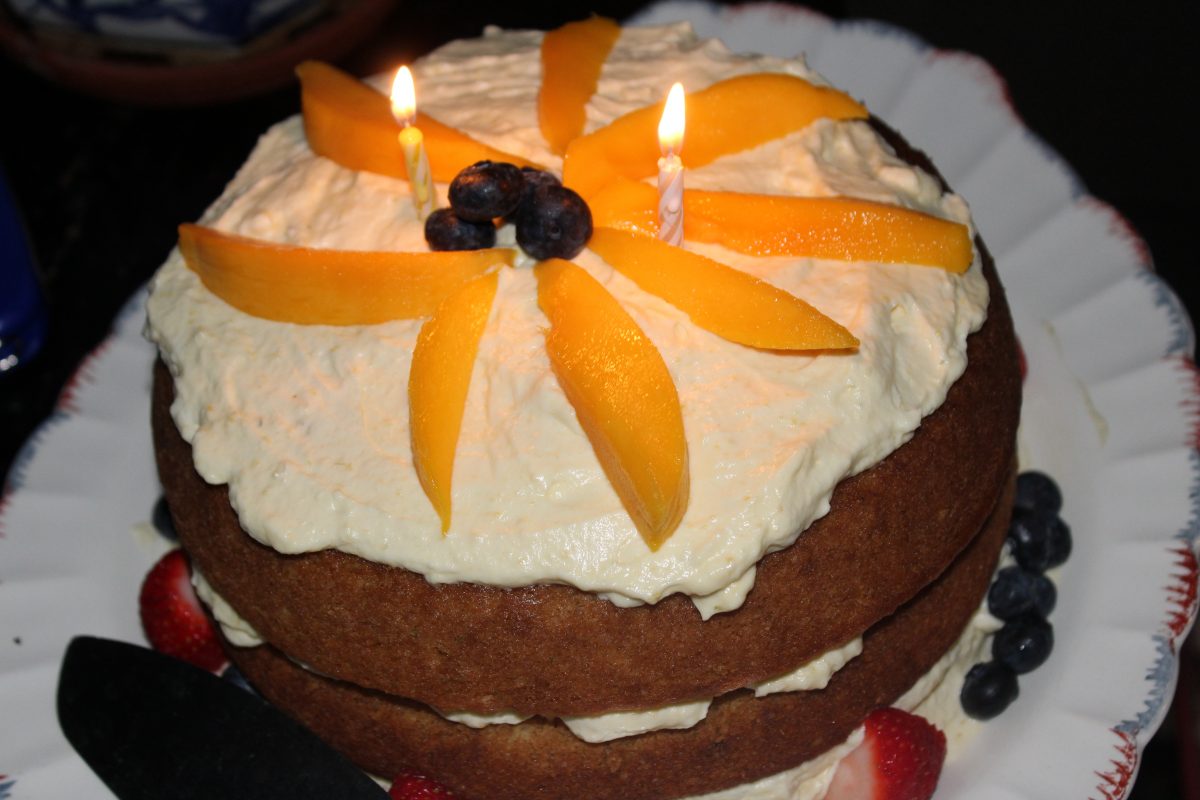
Blueberries
silly soup
It was late last Sunday. We were rushing back from the beach, hungry and sun-beat with chills from diving under the fresh Long Island Sound waves. We found a few leftover containers of chicken stock in the fridge, and with haste, we decided to make a soup by combining all the farmers’ market vegetables we could find and simmering them in the pot while showering off. It all would’ve been fine if we hadn’t felt the need to use up half a lemon on the container. We added all its juice and peel to the pot and it only augmented the bitterness of the Chinese broccoli and Swiss chard. Next time, we’ll opt for cannellini beans and add in some onions and carrots to supplement the sweetness of the beets and combat those bitter greens!
Cucumber, Zucchini and Kaffir Lime Leaf Spread
Ann’s Simple Cabbage Casserole
rosemary shines in shortbread
With three rosemary bushes going gangbusters, it was time to make use of the fresh herb. Craving something a little bit unexpected, I decided to make toasted caraway rosemary shortbread and serve it alongside black raspberries and heavy cream for dessert. The key to achieving the perfect shortbread texture was whipping the chilled butter and sugar together for a total of ten minutes, and then baking in cake pans and slicing into sticks once cooled.
https://www.bonappetit.com/recipe/rosemary-and-toasted-caraway-shortbread
Caprése Salad
We topped fresh heirloom tomatoes from Barberry Hill Farm with all the basil varieties growing in the garden.
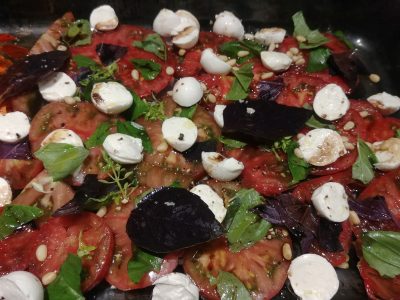
Atlantic Seafood rocks
Shrimp scampi topped with fresh parsley from the garden. Arguably the best-tasting juices around!
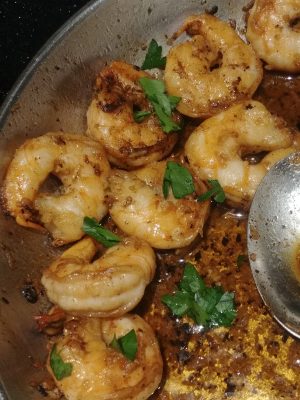
What to do with the last of the strawberries…
Most nights we head back to the house from the Sound or garden much later than anticipated–around 8 pm–and have to scramble to make something yummy with what we’ve got. This was especially true when the supermarkets were closing at 8 pm, but I think the “inconvenience” spurred more creativity. One night we had too many strawberries than we knew what to do with so I decided I would venture from my typical strawberry cream scone recipe and try Jerelle Guy’s strawberry spoon cake that everyone seemed to be raving about since June. It just so happens we found an 8′ by 8′ dish at a yard sale the day before that was just what Chef Guy called for. It was scrumptious! The recipe makes just enough for four people to get a nice big scoop of it. We rode our bikes while it was oven to Ashley’s Ice Cream in town and picked up a pint of sweet cream to pair with the cake. I’m glad I went with this flavor and not vanilla because I think sweet cream’s lack of egg and vanilla made the cake’s flavor’s more prominent than they would have been. The cake itself is eggless and it almost reminded us of a pancake in texture and flavor. We’re very glad we made this one and recommend you try it too before it’s too late and we’re on to blueberry pies! https://cooking.nytimes.com/recipes/1021174-strawberry-spoon-cake
